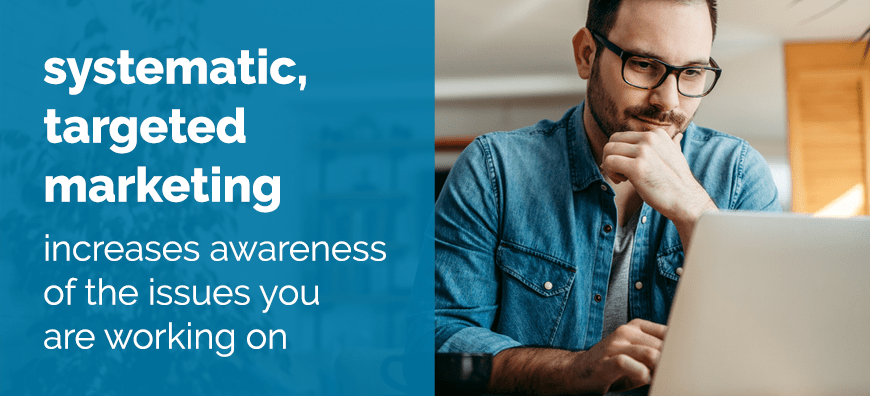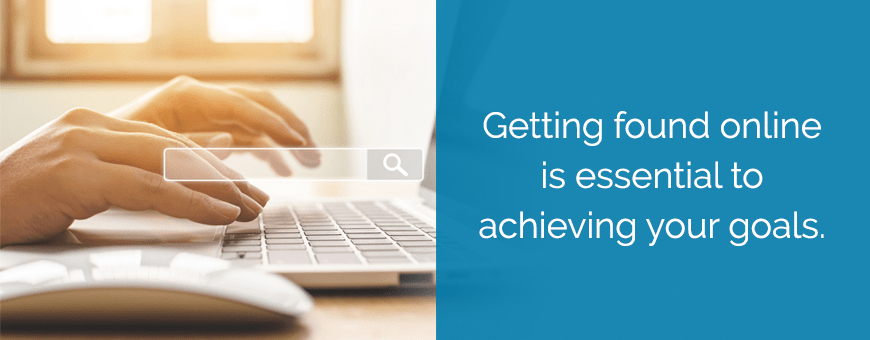
How To Create a Marketing Plan

For some organizations, marketing is something that doesn't come easily. They're trying to do a lot with a small budget and a team that is juggling a lot of responsibilities. We've got good news for you. There is an effective method for applying the groundbreaking principles of content marketing that will amplify your mission, and you can learn about it on this page.
Content marketing is all about getting found by your ideal "customer" by providing the right content to the right people at the right time. The key is creating an engaging online presence that goes beyond just having a website—instead, you have a presence that also includes SEO, social media, email marketing, blogging, and other ways to share your content and use it to convert strangers into customers, friends and supporters.
More good news: content marketing puts the people you want to reach at the center of the process. Businesses called the traditional marketing approach a sales conversion funnel. We believe this linear approach to measuring success is flawed. Putting people at the center of the process builds momentum. In today’s world, it is tone‑deaf to ignore how customers can help organizations grow, and how customers have their needs met by engaging with you.
Consider the difference between a funnel and a flywheel. Funnels lose their power through the process, with conversion to customer being the end of the process. Flywheels leverage energy throughout, harnessing the efforts of all interactions from marketing, to sales and advocates, to keep the process spinning. Also, because flywheels preserve momentum, the more energy you add to spin it, the faster it adds to the process.

When you think about building your organization with a flywheel model instead of a funnel, you'll be able to create an effective growth strategy aligned across your organization. This growth strategy starts with a solid content marketing strategy. Before we go into key steps in creating a plan, let’s review content marketing.
Content Marketing
The internet revolution has turned the tables in the buyer‑seller relationship. It used to be that the seller was in charge of what information to share, and how to promote their products and services.
These decisions are now driven by the user—Google search algorithms are based on what makes the user happy, and social proof is an important metric in brand reputation.
Organizations need to give ideal customers the information they are looking for when they are looking for it. This is the essence of content marketing, putting the customer first.
Content Marketing is about:
- Attracting your ideal customers/donors/members
- Engaging them, converting them into leads and nurturing those leads into customers
- Delighting your customers so they keep coming back AND spreading the word

Using this methodology, all of your teams work together to attract, engage, and delight your customers. You do this by providing an amazing, people‑centered experience throughout the entire journey
Create a Marketing Plan
Your business has a brand, a unique influence. What do people think, feel, or do when they see your name? In order to know where you want to go and determine how to get there, you have to know where your brand is now. Before beginning any kind of marketing plan or activity, you'll need to have a clear understanding of your current reality.
You will need data to understand the current state of your marketing. Key tools for collecting the data are:
- Google Analytics
- Google Search Console
- Social Media Analytics
- HotJar or other website insights tool
- Website Grader
HubSpot’s closed‑loop analytics is a fully integrated tool for excellent data on the performance of online channels, as well as a competitors’ comparison tool
Define where you want to be (goals)
Take the time to establish S.M.A.R.T goals:
- Specific
- Measurable
- Attainable
- Realistic
- Timely

Make sure they are specific, e.g., “to increase site traffic by 20% in the next six months” and “to increase overall donations by 10%.” Your goals should be well documented and shared with all of your stakeholders so that all eyes are on the same prize. A Harvard study showed that the graduates who wrote down their goals were (on average) earning ten times as much as the other 97%.
Turning your mission into S.M.A.R.T. goals
Our friends at Hubspot outline 5 steps to creating a marketing plan.
- Define your marketing goals.
- Understand your audiences.
- Craft your key messages.
- Choose, plan and create your marketing strategies.
- Analyze your marketing performance.

Learn how to position your nonprofit brand
Yodelpop's webinar How to Position Your Brand as an Influencer has great information on how a clear brand identity helps organizations reach the right audience and build trust and affinity.
Positioning your brand goes hand‑in‑hand with furthering your mission. Successful brand positioning goes beyond benefits. It is based on beliefs and values—the core of all nonprofit missions. And it engages supporters on a deeper level.
Case study: The Anti‑Cruelty Society
We love hearing from nonprofits that are using marketing to amplify their impact and share their story with a wider audience. At the American Marketing Association (AMA) Nonprofit & Cause Conference, Jennifer Goodsmith, VP of Mission Advancement at the Anti‑Cruelty Society, provided some great advice for nonprofit branding strategy.
- Mobilize everyone to tell your story.
- Use marketing to share who you are, build a better brand experience, and create a consistent look and feel.
- Communicate with one voice and have marketing be the component that drives your brand platform.
- Make sure everything that goes out into the world fits with your brand voice.
- Build brand awareness.
The most important thing in a nonprofit's marketing plan and strategy, said Goodsmith, is: "how strong your brand is, how authentic you are in what you are talking about. We are always telling our own stories. We are always using our own photos. We are always building off what is real."
This adoption and rescue organization has increased its fundraising 26% from two years ago, Goodsmith reported. That number is concrete evidence of the success the organization has found from implementing a marketing plan rooted in a strong brand identity.
To achieve this type of successful engagement, the first step is to figure out who you want to reach, and then talk about how to best answer their questions and solve their problems.
Identify your ideal audience
(personas/study the audience)
Sharing your mission is about your ideal customers, the pains and challenges they have, and how your organization helps alleviate those pains. If you don’t effectively communicate to your audience “what’s in it for them,” it’s unlikely they’ll ever become customers.
In order to develop messaging and content that speaks to your ideal customers, you need to make sure all content creators know who your ideal audeinces are—with personas.

A persona is a semi‑fictional representation of your ideal audience, based on data about demographics and online behavior, and your experience and educated speculation about their motivations, concerns, and histories.
You can get started creating or refreshing your personas using a persona template.
Plan content strategy/SEO
By now, it won’t come as a surprise that to build an effective content marketing strategy you have to consider the supporter first. Content marketing isn’t about “selling your mission"; it’s about educating. It focuses on attracting your ideal customer to your website by creating and sharing valuable, relevant material that answers the needs, challenges, questions, or problems they have. Providing the right information, to the right person, in the right place.
By examining your benchmark data, you’ll be able to identify how current customers are finding your organization online. You’ll also be able to identify holes—keywords you want to be (or should be) ranking for but aren’t...yet. And you’ll be able to determine which keywords are easy wins—those with high monthly search volume and a low difficulty rating for breaking into the first page of search results.
Keyword research is a key component of any marketing strategy.
Content without keyword optimization is just words, and the chances of reaching your ideal customers online are slim.
Researching keywords, and building them naturally into your content, will help you better optimize your site for search, which will result in more organic traffic, leads, and eventually, customers.
Don’t forget to scope out the competition and determine how difficult it will be to break into the first page of results by conducting searches in the major engines. Tools like Google Adwords and HubSpot SEO will provide you with data like monthly searches and ranking difficulty, making keyword research easier.

Getting found online is essential to achieving your goals and improving your site metrics. If no one is coming to your site, or if you are getting hits to the home page but no one is engaging, how can you increase engagement, membership, or donations?
Based on the goals, do you have the web tools in place to help accomplish those goals?
For example, if you don’t have a blog on your site, it will be difficult for you to increase traffic. If it’s more leads you want, you will need a way of capturing them on your site.
Typically, the more content you have, the more website visitors you will attract, which will grow your customer base faster. It is said that a 100‑page website will beat a 10‑page website 99% of the time. And a 500‑page website is even better, especially when it includes a constant flow of fresh content.
But this content needs to be well organized. Google's search algorithms reward content marketers who
- Build visibility across topics, rather than keywords
- Provide real answers to questions
- Produce long, informational, and authoritative pages
- Publish their content in topic clusters with carefully planned internal links
Organizations are being awarded higher visibility when they publish long, authoritative pages on a core topic (a pillar page), with secondary rewards being given for pages that provide useful information on subtopics of that core topic (topic clusters).
A topic cluster is a group of interlinked content centered on one larger umbrella topic. This larger core topic is the main hub, or pillar page, of your topic cluster. A pillar page is a long, authoritative page that covers all aspects of the core topic in one place with more specific, in‑depth blogs linking back to it.
Your strategy should include a plan to continuously add more and more content around your topic clusters to tell a whole story that makes the case for your organization while answering the public’s questions, as validated by search data.
Brainstorm topics based on your personas. Go back to the profiles you created. They are who you are writing for. What are their pains? What information do they need the most? You can use keyword research to determine which topics you can get the most traction out of.

Be educational and memorable. You are the subject matter expert, and your audience is looking for answers.
Plan premium content
Premium content is an important part of any marketing game plan. Premium content is valuable content that can be used as a gated offer designed to attract and retain a clearly defined audience, and ultimately, to drive that audience to download that offer in exchange for filling out a form and providing more information about them (e.g., name, email, phone number, etc.), then advancing them through the journey to become marketing qualified leads after they download the offer.
Premium content is informational and educational and can take many formats, such as:
- Ebooks
- Case studies
- White papers
- Webinars
- Infographics

Ebooks
Ebooks are pdf documents that provide in‑depth information on a topic of interest to your ideal supporter.
The content is educational, not spammy or promotional. It’s focused on answering a question or solving a problem that you know visitors to your website have. Many times nonprofits have a wealth of content at their fingertips, if you know how to organize, present, and share it.
Case studies
Case studies, including quotes and testimonials, provide examples of how your organization has solved similar problems for your ideal customers in the past. Case studies usually include an analysis or metrics of success that are likely important to them and a description of the steps you took on their behalf that led to successful outcomes.
White papers
White papers demonstrate your expertise and thought leadership by presenting research data, findings, and analysis on a relevant topic.
Webinars
Webinars are excellent opportunities to educate your ideal customers about a topic in a multimedia educational format. Webinars can also be recorded and repurposed in ongoing campaigns as on‑demand offers.
Infographics
Infographics can transform complex topics and dry statistics into visually appealing content. Infographics are highly engaging and are liked and shared on social media three times more than any other type of content.
Optimize website for engagement
Optimizing your website with ample opportunities to convert your visitors into leads and to continue to engage contacts and supporters is key to the process.
The lead generation process often begins when a visitor clicks on a call‑to‑action (CTA) on one of your web pages or blogs. That CTA should take them to a landing page, with a form that will collect their contact information. Once the visitor completes and submits the form, they are then led to a thank‑you page and can be enrolled in a lead‑nurturing process using email marketing.
Other conversion activities on an optimized website include forms where visitors can opt into content‑driven email newsletters that provide added value to contacts, for example, as well as a way to subscribe to a digest of recent blog posts sent to subscribers on a regular basis.
In addition to making sure there are forms for visitors and returning contacts to take action at different stages of the buyer's journey, landing and pillar page templates, and calls‑to‑action, preparing a website for marketing also entails making sure there is a blog section set up that is designed for ease of consuming content and ongoing search engine optimization.
Reach Beyond Your Website Content
Email marketing
Your organization might already be using email to solicit engagement. But you probably can do more to optimize this resource. If you follow best practices for email marketing and keep your personas in mind, it can help you increase conversions and reach your marketing goals.
HubSpot has some suggestions to make use of this personal and powerful tool.
- Create a weekly newsletter featuring your newest content, organizational updates, industry data, and relevant news.
- Set up an email sequence for new subscribers, thanking them for joining and educating them on your organization's mission and goals.
- Set up an email sequence for new customers, thanking them for their business and leading them to the next step of supporting your organization.
You'll want to make it clear to website visitors how they can subscribe and what the benefits are to subscribing to your newsletters.
Learn to segment your audience
Because you'll most likely be dealing with three to five different personas—and leads that are at different stages of the supporter journey—mass email isn't the most effective tool for lead nurturing. Segmentation of your leads is key in engaging with your prospects effectively.
Set up a system of segmentation so that you can send different types of emails to different leads. Create different types of emails for different lists. Examples are: educational emails, best practices, personal email, blog digests, content newsletters.
- Map out which email to send at a given time.
- Use automation and set up triggers around your campaigns so that your leads never miss an email, and so that they receive them at the appropriate time.
- At Yodelpop, we use the HubSpot lead‑nurturing software.
Social media
The goal of organic content promotion on social media platforms is to increase the visibility of your content without spending money on advertising. You can use multiple platforms to promote your content to your fans and followers who can then amplify your messaging by liking and sharing, which can help increase awareness.
Your persona research should tell you which platforms your audience spends the most time on, and where they go to find the information you are sharing.
The goal of social media is to engage your contacts and visitors by driving them back to your content‑rich site, where you can continue to engage with them as they travel through the buyer’s journey.
Advertising
By supplementing your organic promotion efforts with paid content promotion, you can share your most popular, best‑performing content with a highly targeted audience on platforms such as Google, Facebook, LinkedIn, Twitter, and Instagram.
Paid promotion gives you the ability to develop and deliver this relevant and engaging content to specific groups, who will be most receptive, with customized messages.
Analyze & Optimize
To get the results you are looking for from an effective marketing plan, it’s crucial to monitor how the activities are performing and to adjust wherever needed by optimizing throughout.
Sustainable growth rarely happens overnight. It will take patience, consistency, and commitment to stay the course and see the return on investment.
If you’ve set your goals, created a solid plan around those goals, and are following through, then you will begin to see some results. This will encourage you to keep improving and keep going!
Once you establish and are practicing all of the steps in your marketing plan, over time, you will:
- See better and better results.
- Evolve content.
- Streamline systems.
- Tie it together with a sales plan.
- Be inspired by the process.
- Think more out‑of‑the‑box.
- Accomplish your goals!
Want a portable version of this article?

Download a PDF of How to Create a Nonprofit Marketing Plan


